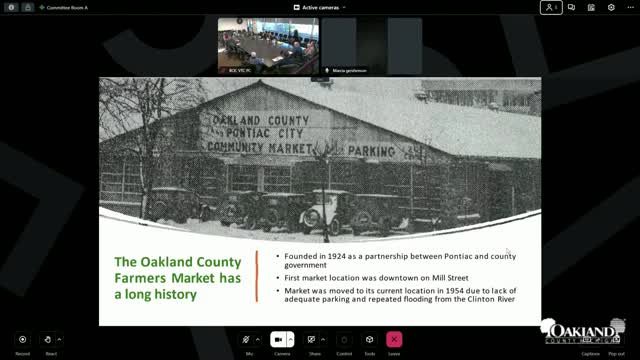Pontiac Farmers Market explores modernization plans and relocation options
April 22, 2025 | Oakland County, Michigan
Thanks to Scribe from Workplace AI , all articles about Michigan are free for you to enjoy throughout 2025!

This article was created by AI using a video recording of the meeting. It summarizes the key points discussed, but for full details and context, please refer to the video of the full meeting. Link to Full Meeting
The farmers market, established in the early 1920s, celebrated its centennial recently. Initially located on Mill Street, it moved to its current site in 1954 due to flooding issues and traffic concerns. The market has since become a vital community hub, featuring 84 vendors who are required to produce or grow their goods, ensuring a focus on local products.
A key topic of discussion was the need for modernization of the market facility, which has seen little improvement in over 70 years. Committee members acknowledged that parking and traffic issues have become increasingly problematic, particularly on busy market days. The current infrastructure does not adequately support modern retail operations, which limits the market's potential for growth and programming.
In 2022, the market received a significant boost with congressional earmark funding of $2.36 million, aimed at facilitating its modernization. However, the release of these funds is contingent upon finalizing plans for the market's future location and operations. The committee emphasized the urgency of resolving these issues to alleviate vendor concerns and ensure the market's sustainability.
The discussion also touched on the possibility of relocating the market to downtown Pontiac, a proposal that has generated mixed feelings among vendors and committee members. Concerns were raised about the viability of such a move, citing examples from other cities where relocating markets did not yield the expected economic benefits. The committee expressed the need for more concrete information from developers regarding potential downtown sites before making any decisions.
Additionally, a resolution was proposed to explore the feasibility of relocating the market to a 100-acre property south of the current location, which has been designated for green space and passive recreational use. Initial feedback from vendors indicated support for this alternative, highlighting the importance of maintaining business continuity for those who rely on the market for their livelihoods.
In conclusion, the committee's discussions underscored the importance of engaging with vendors and addressing their concerns as plans for the market's future are developed. The next steps involve further exploration of potential locations and modernization strategies to ensure the market continues to thrive as a community asset.
Converted from Legislative Affairs and Government Operations Committee Meeting 04-22-25 meeting on April 22, 2025
Link to Full Meeting
Comments
View full meeting
This article is based on a recent meeting—watch the full video and explore the complete transcript for deeper insights into the discussion.
View full meeting